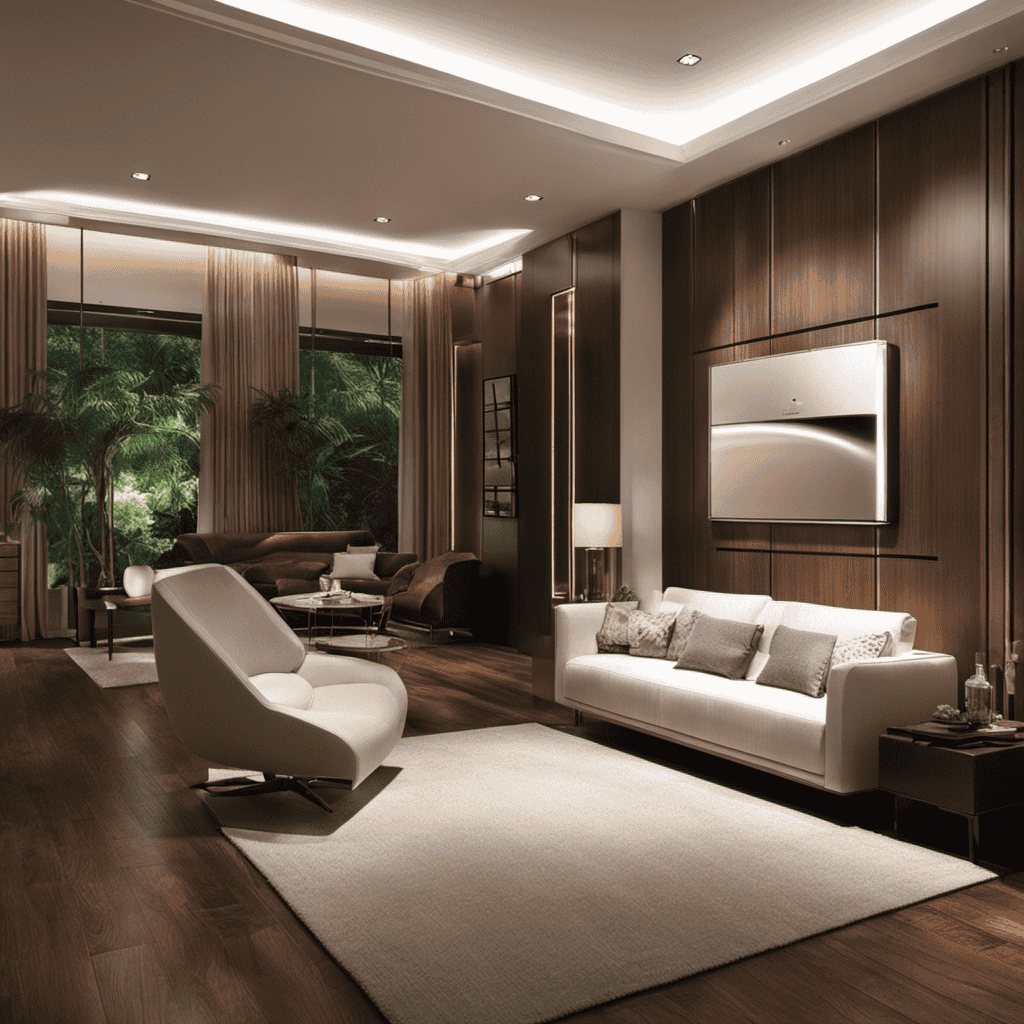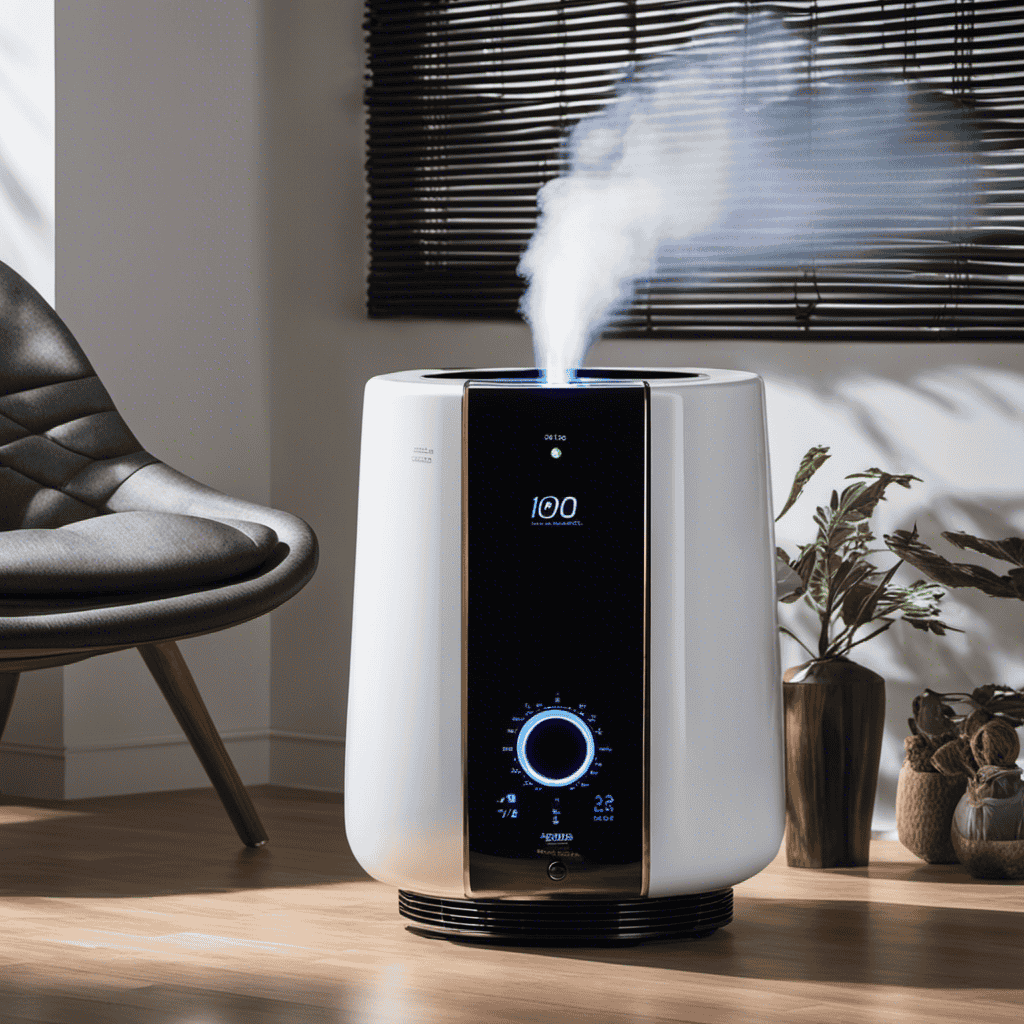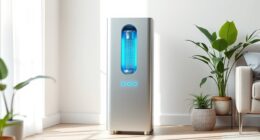I have always been curious about the functioning of ozone air purifiers. You know, those devices that promise to remove airborne pollutants and get rid of odors? Well, get ready to be impressed because after doing some research, I have found that the mechanism behind these purifiers is truly fascinating.
In this article, we’ll delve into the ozone generation process, explore how ozone removes pollutants and tackles odors, and debunk some common misconceptions.
So, if you’re curious about how these purifiers can improve indoor air quality and respiratory health, keep reading!
Key Takeaways
- Ozone air purifiers use electrical currents to create ozone gas through the corona discharge process.
- Ozone molecules are released into the air to react with pollutants.
- Prolonged exposure to elevated ozone levels can cause respiratory problems and worsen existing conditions like asthma.
- Ozone air purifiers can improve indoor air quality by reducing pollutants, removing odors, eliminating bacteria, and neutralizing allergens and contaminants.
Ozone Air Purifiers and Their Mechanism
Ozone air purifiers work by using electrical currents to create ozone gas. This gas then reacts with pollutants in the air to neutralize them. Understanding ozone generation is essential when comparing ozone purifiers.
These devices use a process called corona discharge to generate ozone. Within the purifier, an electrical field is created. Air molecules pass through this field, and the electrical energy breaks apart the oxygen molecules, creating ozone gas. The ozone molecules are then released into the air.
Once in the air, the ozone molecules react with pollutants like bacteria, viruses, and odors. This reaction leads to the neutralization of these harmful substances.
When comparing ozone purifiers, it is crucial to consider factors such as ozone output, coverage area, and safety features. These factors ensure the effectiveness and efficiency of the device.
Understanding the Ozone Generation Process
When it comes to understanding ozone production mechanism, it is crucial to examine the various processes that contribute to its formation. From natural sources such as lightning and UV radiation to human activities like industrial emissions and fossil fuel combustion, these mechanisms release precursor pollutants that react in the presence of sunlight to produce ozone.
However, it is important to note that while ozone plays a vital role in protecting us from harmful UV radiation in the upper atmosphere, at ground level it can have adverse health effects. Ozone air purifiers, despite their popularity, may not be as effective as we think in removing pollutants.
Ozone Production Mechanism
To understand how an ozone air purifier works, you should know that it uses an electrical discharge to convert oxygen molecules into ozone. This process, known as the ozone generation process, involves the breaking apart of oxygen (O2) molecules and recombining them into ozone (O3).
When the electrical discharge occurs, it causes some O2 molecules to split into individual oxygen atoms. These atoms then react with other O2 molecules to form ozone. The ozone produced by the air purifier is then released into the air to neutralize odors and kill bacteria and viruses.
However, it is important to note that ozone can have adverse health effects when present in high concentrations. Prolonged exposure to elevated levels of ozone can irritate the respiratory system and cause respiratory problems. Therefore, it is crucial to use ozone air purifiers in a well-ventilated space and follow the manufacturer’s instructions to avoid any potential health risks.
Health Effects of Ozone
It’s important to note that prolonged exposure to elevated levels of ozone can have adverse health effects, such as respiratory problems and irritation to the respiratory system. Ozone, a highly reactive gas, can cause inflammation in the lungs and worsen existing respiratory conditions, such as asthma and bronchitis. It can also lead to coughing, wheezing, shortness of breath, and chest tightness. Individuals with compromised immune systems, the elderly, and children are particularly at risk.
To mitigate these health risks, safety precautions should be taken. Limiting exposure to ozone is essential, especially in indoor environments. This can be achieved by avoiding the use of ozone-generating air purifiers and ensuring proper ventilation. It is crucial to prioritize the health and well-being of individuals when considering the use of ozone air purification systems.
Transitioning into the subsequent section about ozone air purification effectiveness, it is vital to understand the potential benefits and limitations of such devices.
Ozone Air Purification Effectiveness
Using an ozone air purifier can help improve indoor air quality by reducing certain pollutants. Ozone air purification is an effective method for cleaning the air in your home or office. Not only does it remove odors and eliminate harmful bacteria, but it also eliminates airborne allergens and contaminants.
The ozone molecules produced by the air purifier interact with these pollutants, breaking them down and neutralizing their harmful effects. However, it is important to note that ozone air purification should be used with caution. While ozone is an effective cleaner, it can also be harmful to humans and pets if not used properly.
It is crucial to follow safety guidelines and manufacturer recommendations when using an ozone air purifier to ensure the best results while minimizing any potential risks.
Transitioning to the next section, let’s explore how ozone removes airborne pollutants.
How Does Ozone Remove Airborne Pollutants
Ozone removes airborne pollutants by breaking them down into harmless molecules. The ozone purification process begins when ozone molecules are generated and released into the air. These ozone molecules then come into contact with pollutants such as bacteria, viruses, and organic compounds.
Ozone’s interaction with these pollutants leads to a chemical reaction where ozone molecules oxidize and degrade the pollutants. This process effectively neutralizes the harmful substances, rendering them harmless. The reaction between ozone and pollutants occurs at a molecular level, with ozone molecules breaking apart the chemical bonds of the pollutants. As a result, the pollutants are transformed into simpler, non-toxic molecules.
This ozone purification process ensures that the air we breathe is free from harmful airborne contaminants. In addition to its ability to remove pollutants, ozone also plays a crucial role in neutralizing odors, as will be discussed in the subsequent section.
The Role of Ozone in Neutralizing Odors
The role of ozone in neutralizing odors is essential in creating a fresh and clean environment. As someone who values a pristine living space, I have found that using an ozone air purifier has been incredibly beneficial. Here are three reasons why:
-
Ozone is a powerful oxidizer: Ozone molecules have the ability to break down and eliminate odor-causing compounds at a molecular level. This means that even stubborn smells, like cigarette smoke or pet odors, can be effectively neutralized.
-
Ozone reaches every nook and cranny: Unlike traditional air fresheners or sprays, ozone can penetrate porous materials and reach areas that are hard to clean. This ensures that all surfaces, fabrics, and even the air itself, are thoroughly treated.
-
Ozone is a natural solution: Ozone is a naturally occurring gas that is produced by sunlight and lightning during thunderstorms. By harnessing this natural process, ozone air purifiers provide a chemical-free and environmentally friendly method of odor removal.
While ozone air purifiers offer many benefits, it is important to note their limitations:
-
Ozone can be harmful in high concentrations: Ozone can have negative health effects when inhaled in large amounts. It is crucial to follow safety guidelines and use ozone air purifiers in well-ventilated spaces to minimize any potential risks.
-
Ozone is not effective against all odors: While ozone is highly effective against organic odors, it may not be as effective against certain inorganic odors or chemical compounds. It is important to consider the specific type of odor you are trying to eliminate before using an ozone air purifier.
-
Ozone air purifiers require maintenance: Ozone generators need regular cleaning and maintenance to ensure their effectiveness. This includes replacing filters, cleaning plates, and monitoring ozone levels to prevent overexposure.
Ozone’s Effectiveness Against Mold and Mildew
One of the benefits of ozone air purifiers is that they can effectively eliminate mold and mildew odors. Mold and mildew are common problems in many households, and their presence can lead to various health issues. Ozone air purifiers work by releasing ozone molecules into the air, which react with mold and mildew spores, effectively preventing their growth and eradicating existing colonies.
Here is a table showcasing the effectiveness of ozone air purifiers in mold prevention and mildew eradication:
| Effectiveness of Ozone Air Purifiers | ||
|---|---|---|
| Reduces mold growth | Eliminates mold spores | Prevents mildew formation |
| Destroys mold odors | Eradicates mildew smells | Improves air quality |
| Inhibits mold and mildew | Kills airborne mold particles | Reduces the risk of respiratory issues |
| Effective in small spaces | Removes mold and mildew stains | Provides long-lasting protection |
| Safe for humans and pets | Eliminates the need for harsh chemicals | Eco-friendly solution |
Ozone’s Impact on Bacteria and Viruses
To effectively eliminate bacteria and viruses in your living space, consider the impact of ozone air purifiers. Ozone, a powerful oxidizing agent, has been shown to effectively kill bacteria and viruses by breaking down their cell walls and disrupting their reproductive processes. Here are three ways ozone can have a positive impact on your health and well-being:
-
Ozone’s impact on food preservation: Ozone can be used to disinfect and deodorize food, extending its shelf life and reducing the risk of foodborne illnesses. It effectively eliminates harmful bacteria such as E. coli and Salmonella, ensuring that your food stays fresh and safe to consume.
-
Ozone’s role in water treatment: Ozone is widely used in water treatment facilities to kill bacteria, viruses, and other microorganisms. It is highly effective in removing contaminants and providing clean, safe drinking water. Ozone also helps to improve the taste and odor of water, making it more appealing to drink.
-
Ozone’s ability to break down volatile organic compounds (VOCs): In addition to eliminating bacteria and viruses, ozone air purifiers can also remove harmful VOCs from the air. VOCs are chemicals often found in cleaning products, paints, and furniture, and can contribute to indoor air pollution. Ozone breaks down these compounds, improving the air quality in your home.
With its ability to kill bacteria and viruses, preserve food, treat water, and remove VOCs, ozone air purifiers can greatly improve the cleanliness and safety of your living space. Now, let’s explore ozone’s ability to break down volatile organic compounds (VOCs) in more detail.
Ozone’s Ability to Break Down Volatile Organic Compounds (Vocs
Ozone air purifiers can effectively remove harmful VOCs from the air, improving indoor air quality. VOCs, or volatile organic compounds, are chemicals that can be found in many household products such as cleaning agents, paints, and adhesives. These compounds can have negative health effects when inhaled, and therefore it is important to eliminate them from the air we breathe. Ozone plays a crucial role in eliminating these indoor pollutants. When ozone molecules come into contact with VOCs, they break down the chemical bonds, transforming them into harmless byproducts like carbon dioxide and water. This process, known as oxidation, effectively removes VOCs from the air, leaving behind cleaner and healthier indoor environments.
| VOCs | Ozone Air Purifiers |
|---|---|
| Harmful chemicals | Eliminates |
| Found in household | Breaks down |
| products | VOCs |
With ozone air purifiers, we can ensure that the air we breathe is free from harmful VOCs and other indoor pollutants. But how does ozone air purification actually work? Let’s delve into the science behind it.
The Science Behind Ozone Air Purification
Curious about how ozone air purification actually functions and the scientific principles behind it? Well, let me break it down for you.
Ozone air purification is a technology that has been extensively researched and has seen significant advancements in recent years. Here’s how it works:
-
Ozone generation: Ozone is produced by passing oxygen molecules through a high-voltage electrical field. This creates a chemical reaction that converts oxygen (O2) into ozone (O3).
-
Oxidation: Ozone is a powerful oxidant, meaning it has the ability to break down and destroy airborne pollutants, such as bacteria, viruses, and odors. It does this by reacting with these pollutants and breaking them down into harmless byproducts.
-
Air circulation: Ozone air purifiers use fans to circulate the ozone throughout the room, ensuring that all the air is treated and purified.
Ozone air purification research has led to significant advancements in technology, making these devices more efficient and effective at improving indoor air quality.
With ongoing research and technology advancements, ozone air purifiers continue to be a promising solution for cleaner and healthier indoor environments.
Pros and Cons of Using Ozone Air Purifiers
When it comes to ozone air purifiers, it’s important to consider their disinfection effectiveness. Ozone is known for its ability to kill bacteria, viruses, and mold, making it an attractive option for those concerned about indoor air quality.
However, it’s crucial to also understand the potential health risks associated with ozone exposure, as high levels can be harmful to the respiratory system. Therefore, exploring alternative air purification methods that can achieve similar results without the drawbacks of ozone is worth considering.
Ozone’s Disinfection Effectiveness
You might be interested to know that an ozone air purifier’s disinfection effectiveness is influenced by factors such as concentration and exposure time.
Ozone is a powerful disinfectant that is commonly used in various disinfection techniques, including water treatment. When ozone is used in water treatment, it effectively kills bacteria, viruses, and other microorganisms by damaging their cell membranes and DNA.
Here are some key points to understand about ozone’s disinfection effectiveness:
-
Concentration: The concentration of ozone in the air or water directly affects its disinfection effectiveness. Higher ozone concentrations generally result in better disinfection.
-
Exposure Time: The longer the exposure time to ozone, the more time it has to come into contact with microorganisms and effectively destroy them.
-
Microorganism Type: Different types of microorganisms have varying susceptibilities to ozone. Some may be more resistant and require higher ozone concentrations or longer exposure times for effective disinfection.
Understanding these factors is crucial in optimizing the disinfection process and ensuring the effectiveness of an ozone air purifier or water treatment system.
Health Risks of Ozone
In my previous section, I discussed the effectiveness of ozone as a disinfectant. Now, let’s delve into the health risks associated with ozone and the safety precautions that should be taken when using ozone air purifiers.
Ozone, when inhaled, can be harmful to our health. It is a highly reactive gas that can irritate the respiratory system, causing coughing, throat irritation, and shortness of breath. Prolonged exposure to high levels of ozone can even lead to lung damage and worsen existing respiratory conditions such as asthma.
To ensure the safety of users, it is essential to follow certain precautions when using ozone air purifiers. First, it is crucial to monitor ozone levels in the air and ensure they are within safe limits. Second, limit exposure to ozone by using the purifier in well-ventilated areas and avoiding prolonged exposure. Finally, it is advisable to consult with a healthcare professional before using an ozone air purifier, especially if you have a pre-existing respiratory condition.
To help you understand the health risks and safety precautions associated with ozone air purifiers, here is a table summarizing the key points:
| Health Risks of Ozone | Safety Precautions |
|---|---|
| Irritation of the respiratory system | Monitor ozone levels |
| Coughing and throat irritation | Use in well-ventilated areas |
| Shortness of breath | Limit exposure to ozone |
| Lung damage and exacerbation of respiratory conditions | Consult with a healthcare professional |
Alternative Air Purification Methods?
One alternative method for purifying the air is through the use of activated carbon filters. These filters are designed to remove harmful pollutants and odors from the air by adsorbing them onto the surface of the carbon particles. Activated carbon has a large surface area and a high adsorption capacity, making it an effective tool in air purification.
Here are three benefits of using activated carbon filters as an alternative air purification technology:
-
Eco-friendly: Unlike some other air purifiers that rely on chemicals or ozone, activated carbon filters do not release any harmful byproducts into the air. They are a more sustainable and environmentally friendly option for purifying the air in your home or office.
-
Versatile: Activated carbon filters can effectively remove a wide range of pollutants, including volatile organic compounds (VOCs), smoke, and unpleasant odors. This makes them suitable for various environments, from homes to workplaces.
-
Long-lasting: Activated carbon filters have a relatively long lifespan compared to other types of filters. With proper maintenance and regular replacement, they can continue to provide clean and fresh air for an extended period of time.
Safety Precautions When Using Ozone Air Purifiers
Make sure to follow safety precautions when using ozone air purifiers to ensure the well-being of yourself and others. Ozone air purifiers are effective in removing odors and killing bacteria, but they can also produce ozone, a harmful gas that can cause respiratory issues and other health problems if not used correctly. Here are some safety measures to consider:
| Precaution | Explanation |
|---|---|
| Ventilation | Ensure proper ventilation in the room where the ozone air purifier is being used to prevent ozone buildup. |
| Time Limit | Limit the usage of ozone air purifiers to short periods of time, typically no more than a few hours at a time. |
| Occupancy | Do not use ozone air purifiers in occupied spaces, as the concentration of ozone can be harmful to humans. |
Ozone Air Purifiers Vs. Traditional Filtration Systems
When comparing ozone air purifiers to traditional filtration systems, it’s important to consider their effectiveness in removing pollutants from the air.
Ozone air purifiers work by emitting ozone molecules that react with and neutralize odors, bacteria, and other airborne contaminants. However, while ozone can be effective in eliminating some pollutants, it’s important to note that it can also be harmful to human health, especially in high concentrations.
Traditional filtration systems, on the other hand, use filters to trap particles and pollutants, providing a safer and more reliable method of air purification.
Ozone Vs. Filters
Ozone air purifiers, unlike traditional filters, use ozone to eliminate airborne pollutants. This technology sets them apart from HEPA filters, which rely on physical filtration to trap particles. Here’s why ozone air purifiers have unique advantages:
- Ozone air purifiers vs. HEPA filters:
- Ozone air purifiers can neutralize a wider range of pollutants, including bacteria, viruses, and odors, whereas HEPA filters are designed primarily for trapping larger particles like dust and pollen.
- Ozone air purifiers can reach areas that are difficult for filters to access, such as crevices and fabrics.
- Ozone air purifiers are more effective at breaking down volatile organic compounds (VOCs), which can be found in household items like cleaning products and furniture.
These benefits make ozone air purifiers a suitable choice for individuals with allergies, as they can help reduce allergens in the air. However, the effectiveness of ozone in air purification is a topic of debate, which we’ll explore in the next section.
Effectiveness of Ozone?
To determine if ozone air purifiers are effective, you can consider various factors such as the size of the space you want to purify and the specific pollutants you are trying to eliminate.
Ozone air purifiers work by producing ozone, a molecule composed of three oxygen atoms. This ozone reacts with pollutants in the air, oxidizing them and breaking them down into simpler, harmless molecules. However, the effectiveness of ozone air purifiers can vary depending on the concentration of ozone produced, the duration of exposure, and the type of pollutants present.
It is important to note that ozone can be harmful to humans and pets in high concentrations, so safety precautions must be taken when using ozone air purifiers. This includes ensuring proper ventilation and using them in unoccupied spaces.
Now, let’s address some common misconceptions about ozone air purifiers.
Common Misconceptions About Ozone Air Purifiers
There’s a misconception that ozone air purifiers are harmful to human health, but this is not necessarily true. Ozone air purifiers, when used correctly and in moderation, can be safe and effective in improving indoor air quality.
To debunk the myths surrounding ozone air purifiers, consider the following:
-
Ozone concentration: Contrary to popular belief, ozone air purifiers do not emit high levels of ozone. The concentration produced is typically low and within safe limits, posing minimal risk to human health.
-
Duration of exposure: Ozone air purifiers are designed to be used intermittently and for short durations. This prevents prolonged exposure to ozone, minimizing any potential negative effects.
-
Ozone generation: Advanced ozone air purifiers utilize technology that minimizes the generation of harmful byproducts, ensuring cleaner and safer indoor air.
Factors to Consider When Choosing an Ozone Air Purifier
When choosing an ozone air purifier, you should consider factors such as room size, filtration technology, and noise level. These factors play a crucial role in ensuring the effectiveness of the purifier and the overall air quality in your space.
Firstly, room size is important because ozone air purifiers have a limited range and need to be able to effectively treat the air in the entire room.
Secondly, filtration technology determines how efficiently the purifier can remove pollutants from the air. Look for purifiers with advanced filtration systems that can capture a wide range of contaminants.
Lastly, noise level is a consideration for those who require a quiet environment. Ozone air purifiers with low noise levels ensure that you can enjoy clean air without any distractions.
Ozone Air Purifiers and Indoor Air Quality Improvement
Improving indoor air quality is crucial, and ozone air purifiers can help achieve this goal by effectively removing pollutants from the air. Ozone air purifiers work by generating ozone, a highly reactive molecule that attaches to airborne pollutants and neutralizes them.
Here are three benefits of using ozone air purifiers:
-
Elimination of odors: Ozone molecules break down and remove unpleasant smells, such as those from pets, cooking, or cigarette smoke.
-
Reduction of allergens: Ozone air purifiers can effectively reduce common allergens like dust mites, pollen, and mold spores, providing relief for allergy sufferers.
-
Destruction of bacteria and viruses: Ozone has antimicrobial properties that can help eliminate harmful microorganisms, including bacteria and viruses, improving overall air quality and reducing the risk of infections.
Ozone Air Purifiers and Their Impact on Respiratory Health
When it comes to ozone air purifiers, it’s important to consider their potential impact on respiratory health. Ozone, a reactive gas, can have harmful effects on the respiratory system, especially in high concentrations.
It can irritate the lungs, trigger asthma attacks, and worsen existing respiratory conditions. Therefore, it is crucial to examine the safety of ozone purifiers and explore alternative options that can effectively improve indoor air quality without compromising respiratory health.
Ozone’s Respiratory Health Effects
To understand how an ozone air purifier affects your respiratory health, it’s important to consider the potential risks and limitations associated with ozone exposure.
Ozone, a molecule composed of three oxygen atoms, plays a crucial role in environmental pollution. While it is a beneficial component of the Earth’s upper atmosphere, at ground level, it can be harmful to human health. Ozone can irritate the respiratory system and cause inflammation in the lungs, leading to breathing difficulties and exacerbating existing respiratory conditions. Its impact on lung function includes decreased lung capacity and increased susceptibility to respiratory infections.
It’s crucial to be aware of these effects when considering the use of ozone air purifiers.
Now, let’s explore whether ozone purifiers are safe for use.
Are Ozone Purifiers Safe
It’s important to consider the safety of ozone purifiers when deciding whether to use them in your home. While ozone purifiers can effectively remove odors and disinfect the air, they also come with certain risks. Ozone, a highly reactive gas, can be harmful to human health when present in high concentrations. It can irritate the respiratory system, cause coughing, and worsen asthma symptoms. To ensure the safe use of ozone purifiers, it is crucial to take necessary precautions. Here are some key safety measures to consider:
| Ozone Purifier Safety Precautions |
|---|
| Properly ventilate the room |
| Limit exposure time |
| Follow manufacturer’s instructions |
| Use in unoccupied spaces |
Alternatives to Ozone Purifiers?
After learning about the potential dangers of ozone purifiers, I started looking for safer alternatives. In my search, I discovered that there are several options available for natural air purification. Here are some alternatives to ozone purifiers that I found:
-
HEPA Filters:
-
These filters remove particles as small as 0.3 microns, including dust, pollen, and pet dander.
-
HEPA filters are highly effective in improving indoor air quality and are commonly used in hospitals and cleanrooms.
-
They are safe and do not produce any harmful byproducts.
-
Activated Carbon Filters:
-
These filters are excellent at capturing odors, chemicals, and volatile organic compounds (VOCs).
-
Activated carbon has a large surface area that adsorbs harmful substances, effectively purifying the air.
-
It is a natural and safe method of air purification.
-
Plants:
-
Indoor plants can naturally filter and purify the air by absorbing toxins and releasing oxygen.
-
Certain plants, such as the snake plant and peace lily, are known for their air-purifying abilities.
-
Having plants in your home not only improves air quality but also adds a touch of greenery to your space.
Frequently Asked Questions
Are Ozone Air Purifiers Safe for Pets and Children?
Ozone air purifiers can effectively remove pet dander and hair, but they pose potential health risks for children. The high levels of ozone can irritate the respiratory system and cause breathing difficulties.
Can Ozone Air Purifiers Remove Cigarette Smoke Smell?
Yes, ozone air purifiers can remove cigarette smoke smell. They work by producing ozone, which oxidizes and breaks down the smoke particles. However, ozone can be harmful to respiratory health and overall indoor air quality.
How Long Does Ozone Take to Neutralize Odors?
I’ve found that it typically takes ozone about 30 minutes to neutralize odors. To properly clean an ozone air purifier, it’s important to follow the manufacturer’s instructions. The benefits of using an ozone air purifier in your home include removing allergens and eliminating unpleasant smells.
Can Ozone Air Purifiers Eliminate Allergens Like Pollen and Dust Mites?
Ozone air purifiers can effectively eliminate allergens like pollen and dust mites, improving respiratory health. Studies show that these purifiers can reduce airborne allergens by up to 99%, providing relief for allergy sufferers.
Do Ozone Air Purifiers Have Any Negative Effects on Furniture or Electronics?
Ozone air purifiers can have negative effects on furniture and electronics. The ozone produced can react with certain materials, causing them to deteriorate over time. Additionally, high levels of ozone can pose potential health risks to humans.
What are the Differences Between Ozone and Regular Air Purifiers?
Ozone and regular air purifiers use different air purifier operation techniques. Ozone purifiers release ozone molecules to neutralize odors and pollutants, but can be harmful to humans. Regular air purifiers use filters or UV light to capture and destroy contaminants without producing harmful ozone. Choose the right one for your needs.
Conclusion
After learning about how ozone air purifiers work, I am amazed at the effectiveness of this technology in improving indoor air quality. The ozone generation process, combined with its ability to remove airborne pollutants and neutralize odors, makes ozone air purifiers a great choice for anyone concerned about their respiratory health.
It’s fascinating how ozone can also combat mold and mildew, providing a cleaner and healthier environment. When choosing an ozone air purifier, it’s important to consider factors such as room size and ozone output.
Overall, ozone air purifiers have a significant impact on improving indoor air quality and promoting better respiratory health.










